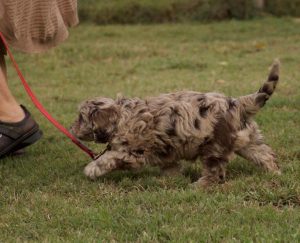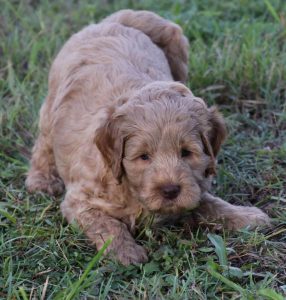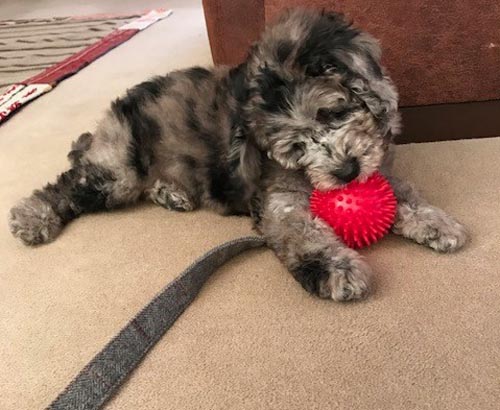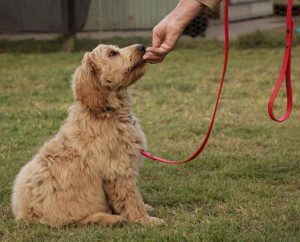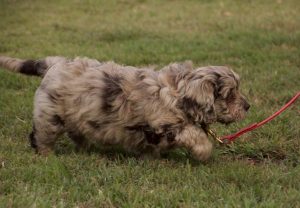PUPPY LEASH TRAINING
Cobberdogs are part of the family, and outings with the family are part of your Cobberdog’s day. In most places, dogs are required to be on leash… Without some early intentional leash training, your clever Cobberdog puppy will develop bad habits as quickly and easily as good habits, and being pulled along the street by a choking dog is not fun or satisfying for you or your pet!
Do you want to be walking your dog, or do you want your dog to be walking you?
Follow our simple guide for the basics of leash training, and have a puppy that is easy to take out with you on leash, and easy to progress in training.
CLICK HERE to see our video of early leash training of a young puppy.
Starting from Day 1...
It is so important to do at least 2 deliberate leash training sessions every day from the first day your puppy is home. But please don’t just take your new little puppy for a big walk around the block! The pup will tire very easily and this will be stressful and even damaging to their little joints.
Train, Play, Train, Play
Apart from tiring quickly, your new puppy has a short attention span and loses focus quickly. Therefore, small five minute training sessions are enough to begin, followed by a play break together; play a tug toy game for example. By playing between training, your puppy learns to enjoy his training and associates being with you as always involving fun.
Training with Dog Treats
Use healthy treats like little pieces of dried liver or jerky to teach and reward positive behaviour. It is important that the treat is really small, so that your little pup can chew and swallow it quickly and then training can continue.

Collar and Leash Introduction
Begin, Day 1, with simple introduction to collar and leash. We recommend a small flat collar and a light leash for little pups. At first, just have the puppy wear them indoors while you play with him and give him treats. The puppy will quickly associate collar and leash with food and fun!
Take your Time
When starting walking with leash, do everything calmly, patiently and gently. Sometimes even just standing still or kneeling down while your pup figures out what is happening is a good idea; then give the treat when your pup does what you asked of him.
Teach a Treat Cue
Teaching a treat cue at this early stage while playing indoors with the collar and leash on, will make further training easier. Decide a word or sound (tongue click, finger click or such), and in a quiet undistracted place, make the sound and as soon as your pup turns to investigate, give a treat. Repeat a few times, and very quickly, your pup will come right to you looking for a treat. Reward the pup each time, and pretty soon he will not just associate the cue with a treat, but he'll unconsciously decide that coming to you is the best thing ever!
Walking with Leash
When first starting walking with the leash, don't attempt to get pup to walk beside you; just following is great. Very often young pups will spontaneously want to follow you, especially if you use your treat cue, and this makes training easy; but for many pups the collar and leash can be a little restricting and can create resistance in the puppy. If your pup resists and sits down and won't budge, don’t yank or pull him along; that will only increase his resistance. Walk a few steps away until there is slight tension on the leash, then stand still and encourage him forward with your treat cue. Your puppy will start to understand that when he comes forward (looking for a treat) the tension on the collar is also released and it feels better. Always give him a treat him for his decision. Once your pup comes to you, take a few steps back as he approaches, reward, set off walking again and repeat the above. If the pup follows along without resistance, sound your treat cue, walk a few steps, then give the treat; repeat. With a little repetition, the pup will happily follow along, anticipating and enjoying further treats. With a little time, there will be no resistance in following on the leash, and treats will eventually be unnecessary.
Progressing Leash Training
Remember we said that small five minute sessions are enough for a small pup before you have a play break; try the small training session a few times in the day. As your pup gets older you can increase the length of training sessions and start to go for longer walks. Use your pup's attention span and signs of tiredness as a guide. Going out for longer walks is usually where people strike trouble, where pup gets excited with his surroundings on his walk and starts to pull or want to go faster. This is simple to remedy but takes persistence. You want your puppy to be focused on you and not what's ahead of him. So right from the start a frequent change of direction will keep him focussed and wondering what’s happening next. Walk along two to three metres then turn around and go back the other way! Treat him when he starts to turn with you. Repeat this often, so you may want to use this technique in your own yard until your pup stops pulling. While out walking if he starts to pull at any time, just repeat the exercise till he starts walking with you. Make sure you carry some little treats with you on these training walks!
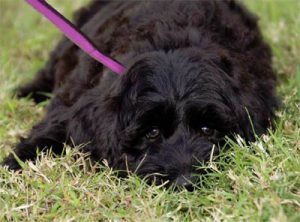
Be Patient and Persistent
Take your time and keep your cool, but be persistent in what you do to achieve the results you want. Even if the results are only a small step towards what you wish to achieve, in time, the small steps become the big ones you seek. Very quickly you will find your dog accepting the leash and eventually he will come to walk nicely on it as well. When your puppy has become responsive on the leash, start with short walks along the street to the coffee shop or newsagent! If you see signs of fatigue or stress, pick your puppy up and carry it. With time, as the puppy grows and becomes stronger, you will be able to walk around the block and eventually further.
Walking Beside You
As your pup gets bigger, use a treat held in your hand down by your side at his head level to get him walking alongside you on the leash instead of behind, and then occasionally make him stop and sit and give him the treat. You can give a treat while he is still walking beside you sometimes too, to reinforce that it is good to walk beside you.
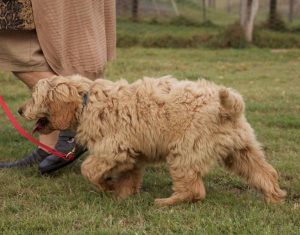
Now you understand the basics of leash training for your new puppy, and being able to enjoy short walks together. When you take your puppy to Puppy School, you and the puppy will continue to learn more ways to work together to enjoy being out together using the leash. Happy walking!

